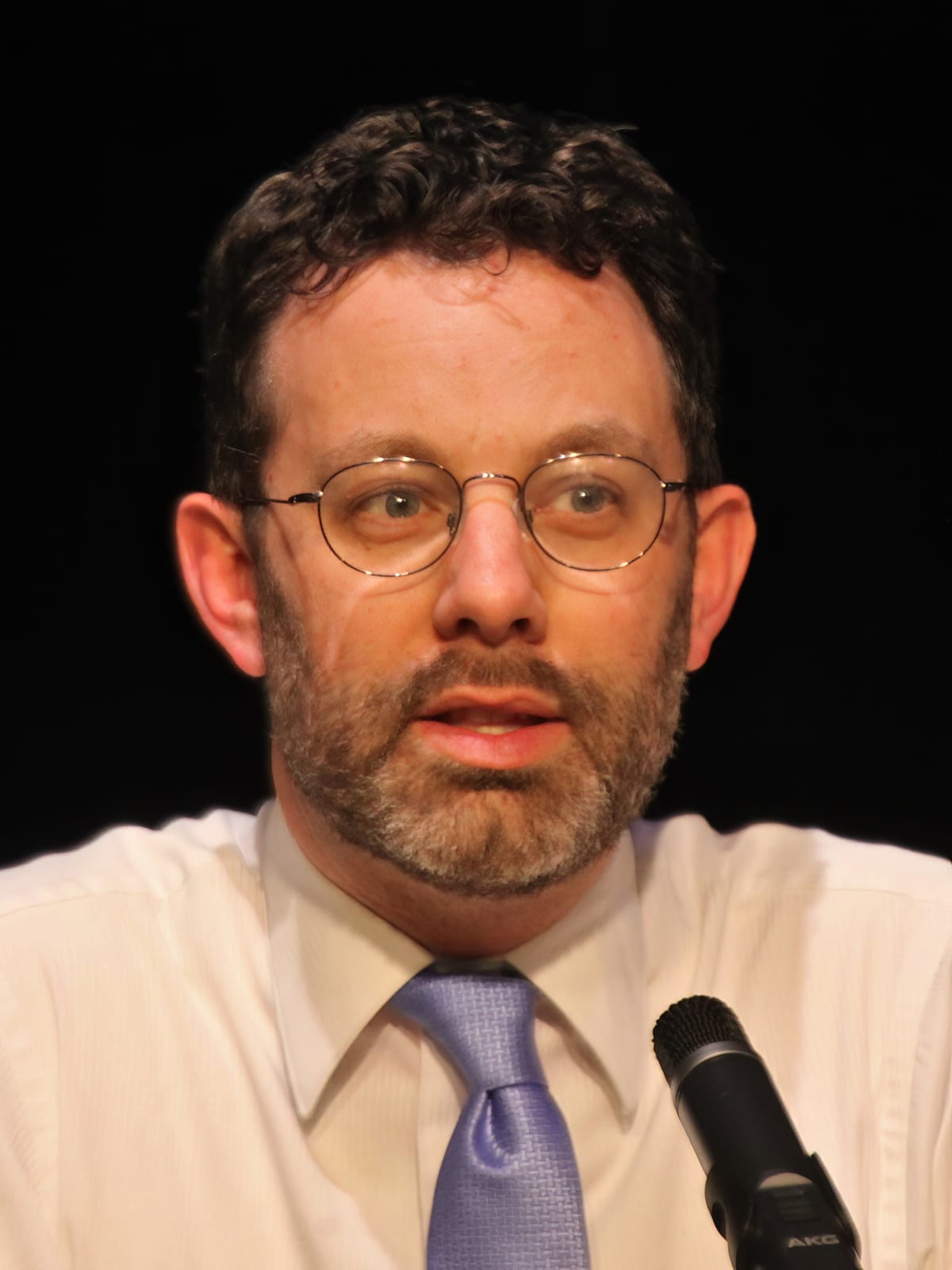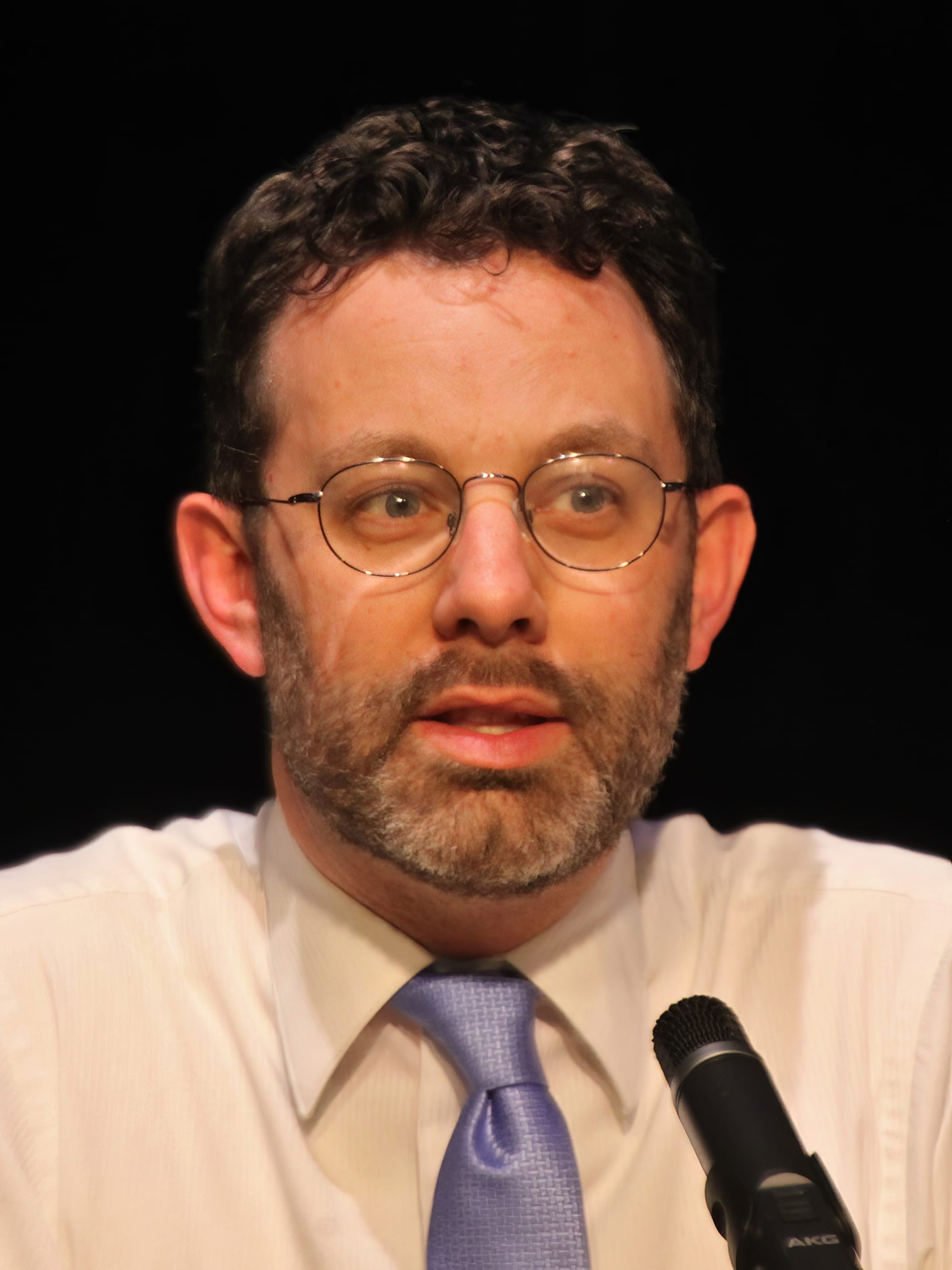County commissioner candidates Peter Iversen, Julie Thomas field questions on new jail, housing



On Saturday afternoon, a total of five candidates in two different Democratic Party primary races for county commissioner fielded questions at a forum hosted by League of Women Voters of Bloomington-Monroe County.
The forum took place in the auditorium of the downtown Bloomington location of the Monroe County Public Library.
In one race, incumbent Julie Thomas is competing with Peter Iversen for the party’s nomination. Iversen currently serves on the county council.
In the other race, incumbent Penny Githens is competing for the nomination with Jody Madeira, an Indiana University law professor, and Steve Volan, a former Bloomington city councilmember.
As a group of five, over the course of 90 minutes, they answered a dozen questions that asked for their thoughts on a new jail, housing, and more.
This report focuses on just the race between Thomas and Iversen. The B Square will report on the other race separately.
At a mid-February event hosted by the Building Association of South Central Indiana (BASCI), Iversen and Thomas answered questions from moderator John Fernandez, who is now vice president for innovation and strategic partnerships at The Mill.
The full forum from Saturday (March 23) is available to watch on CATS. Below is a summary of just a few highlights, which are not necessarily organized in the chronological order of the forum.
The event was cosponsored by the Greater Bloomington Chamber of Commerce, Monroe County NAACP, Monroe County NOW, IU PACE, IU BIG Voting Challenge, and Alpha Kappa Alpha Sorority, Kappa Tau Omega Chapter.
Moderating the forum was Maria Douglas who is development director for Middle Way House.
Housing: General
Iversen has made housing a central issue in his campaign. In his mid-June news release announcing his intent to run for the county board of commissioners, the first bullet point on his list of focus points was “a housing supply that meets local demand.”
At Saturday’s forum, Iversen’s opening remarks included as a highlight the 10-point housing plan on his campaign website.
Iversen took a seemingly unrelated question, about the growing number of Asian American voters and how candidates would reach out to them, and pivoted to housing. The question that moderator Maria Douglas put to the candidates was: “Since Asian Americans are the fastest growing voter population, what are your plans to engage them and then serve them?”
After stating that “Racism, and acts of violence have no place in our community. Full stop,” Iversen said: “My plan for this community involves wealth creation, and income building—both of those impact directly the Asian American communities that choose to live here.”
Iversen continued, saying “My fear is that if we don’t reverse course, if we don’t have a change in the board of commissioners in terms of housing, that we will continue to see members of the Asian American community leave Monroe County, because they are experiencing the same thing the other members of the community are: There is simply not enough housing for people to live here that want to live here.”
As part of his answer to the question about Asian American voters, Iversen pointed to three occasions in 2021, when the county board of commissioners voted unanimously against rezones for projects that would have provided more housing.
The three occasions Iversen has in mind are: The Trails, a 125-home neighborhood, which was denied a rezone petition in September 2021; Southern Meadows, a 190-home workforce housing neighborhood for which a requested rezone was denied by commissioners in June 2021; and Clear Creek Urban, a proposal for a neighborhood cluster that included 31 new units of housing, which was rejected by the county commissioners in May 2021.
When Iversen has mentioned those three rezone denials at previous events, Thomas has responded by talking about the rezones that the commissioners have approved, including Westgate on 3rd Street, and The Lakes at Sare and Rogers roads.
At the forum held at the Democrats Club lunch meeting at DeAngelo’s on March 19, Thomas put it like this: “We have had a number of planning developments that we have approved—Westgate, The Lakes at Sare and Rogers.” She added, “These are in areas that are appropriate for high-density development.”
Thomas added, “It is a falsehood to say that we don’t do development.” Thomas wrapped up by saying, “We do it, but we do it responsibly, because we already live here. And we need to protect what we have.” That was met with applause from several attendees at the DeAngelo’s lunch meeting of the Dems.
At Saturday’s forum, on two occasions candidates were asked specifically about housing. The first question was about balancing housing against climate change. The second question asked specifically about rental housing.
Housing: Climate change vs. Housing
The first question was: What will you do to mitigate climate change impacts in Monroe County? And how will you do that while balancing the need for more housing?
Iversen’s turn came before Thomas’s. He led off by citing his work with Indiana University’s Environmental Resilience Institute, to start developing a climate resiliency plan for the county.
His reaction to the housing part of the question was to say that it’s possible both to increase housing supply and mitigate against climate change. He put it like this: “I don’t think this is an either-or question. I think that our community is talented enough and smart enough to do both.”
Iversen continued, “I think that we can build more housing for the residents that want to move here, and at the same time, protect our wetlands.” Iversen added, “I think that we can build more houses and at the same time, ensure that we’re not building in our growing floodplains.”
Iversen wrapped up by saying, “I think that we can go ahead and build more housing in the county and not put it on top of karst features.”
In her response, Thomas cited the legal efforts of the county commissioners to fight the Hoosier National Forest’s clear-cutting plan for land near Lake Monroe. “If we don’t have clean drinking water, we don’t have anything,” Thomas said.
Absent a sewer connection, Thomas said that denser housing in some areas would require a “package plant.” That’s a kind of wastewater treatment facility for treating sewage that is nevertheless compact and self-contained. A package plant incorporates the various phases of treatment, like sedimentation, aeration, filtration, and disinfection.
Package plants have their own requirements, Thomas said. If there is no package plant and there is no sewer connection, there is a one-acre minimum lot size, because that is the state requirement for a septic system, Thomas said. “If you don’t like the one-acre density, OK, we can ask for a connection to a sewer.”
It is CBU (city of Bloomington utilities) that would need to make a sewer connection. But while the annexation litigation is pending, Bloomington’s policy has been not to make any new sewer connections outside the city limits. Related to a current county government effort to collaborate with Habitat for Humanity on a housing project, Thomas said that Bloomington had declined to give the project access to city sewer service. Thomas wrapped up by saying, “So we have a lot of work to do.”
Housing: Rentals
The rental housing question was: Should the county encourage rental housing? And if so, how should its habitability be ensured?
Iversen also got first crack at the question. He said that his campaign has reached thousands of residents so far, and the one thing that he hears consistently from door knocking and talking on the phone is: “We need more housing, Peter. We need more housing.”
Iversen said that many people think that more housing just means big apartment complexes like those that are being constructed on the east side of Monroe County. But Iversen called for housing that is “on a spectrum.” Iversen continued, “Folks don’t want the government to tell them where to live. They want the government to reduce barriers, so they can choose where to live, based upon their lifestyle.”
It’s that ability to choose, Iversen said, that is at the heart of the question. He said, “Yes, we need more rental space, but we also need more multi-family homes. We also need more single-family homes.”
Thomas used some of her time to respond to a characterization of a provision in the draft CDO (county development ordinance) as downzoning 9,300 acres. It’s a characterization that Iversen has previously given, even if on Saturday it was given by another candidate. The county development ordinance (CDO) is analogous to Bloomington’s unified development ordinance, but applies just to land in the unincorporated portion of Monroe County.
On Saturday, Thomas said she wanted to “break the myth” about the 9,300 acres being downzoned from residential to rural. “The 9,300 acres were not moved from residential to something else,” Thomas said. The land was simply moved to a new column, labeled “Rural,” but still in the category of “Residential.”
On the question of rental units, Thomas said, “Yes, we do need rentals.” She continued, “I’m not going to mock somebody who wants to live on an acre or two, nor somebody who wants to live in a townhome.” Thomas added, “But we do have to provide better opportunities for rental.”
On the question of protecting renters, by ensuring that the property would remain habitable, Thomas said she is working with the county board of health to come up with regulations that judges can enforce when they have to deal with these housing issues.
About the idea of implementing a rental inspection program, along the lines of the one administered by Bloomington’s housing and neighborhood development (HAND) department, Thomas was not enthusiastic. She put it like this: “We don’t want to recreate a huge bureaucracy like HAND—we don’t need something that large.”
New jail
By way of background, in 2008, the ACLU filed a lawsuit stemming from conditions at the jail, and the jail is now operating under a settlement agreement, reached in 2009, which has been extended several times. The work of two consultants was delivered to the county more than two and a half years ago, which included a conclusion that the current facility is “failing.”
For B Square background on the question of the need for a new county jail, see: Monroe County sheriff, commissioners square off at committee meeting, ACLU lawyer says: “Look, you need a new jail. Everyone knows that.”
On Saturday, candidates were given two questions related to planning for a new Monroe County jail.
New jail: Design, location, the sheriff
Saturday’s first question about the jail was: What have you learned about jail design and location from conversations with Monroe County sheriff Ruben Marté?
Iversen again had first crack at the question. He spoke from his perspective as a Monroe County councilor. “Sheriff Marté and I have a very positive working relationship,” Iversen said.
That could be analyzed as a contrast to the rocky patch that county commissioners had with Marté, after he was sworn into office at the start of 2023. There were two episodes that got aired out publicly, because Marté wrote lengthy email messages on the topics.
One situation involved the hiring of a jail technician who would handle basic repairs. Marté felt that commissioners were slow-footing the process.
The other situation was the sheriff’s concern about the lack of transparency in the process for selection of an architect for the new jail. Indiana’s public access counselor eventually opined that in connection with that process, a committee meeting should have been open to the public.
In his response to Saturday’s question, Iversen said, “We have not been able to do a lot with sheriff Marté and his vision for the community, because of the roadblocks that the current county commissioners have put up.”
Iversen said that as a member of the county council’s justice fiscal advisory committee (JFAC), he made sure that Marté was a part of discussions about design options for the new jail. Iversen ticked through some things he’s learned from Marté. First, Iversen said, the new jail should allow for future planning. To avoid overcrowding, Iversen said, “We need to build a facility that can expand or shrink based upon the current needs of the community.”
A second thing Iversen reported learning from Marté is that staffing is key, because that would be the highest cost in the new jail. Iversen said right now it’s not possible to know how many correctional officers will be needed to staff the new jail, because “there’s no design from the commissioners.”
A third thing Iversen said he’d learned from Marté is that the transition team is “vitally important.” Iversen said, “I’ve been in favor of funding this team.”
Iversen’s comment could have been analyzed as a criticism of some initial reluctance that commissioners had expressed about sourcing of the funds for the transition director from the American Rescue Plan Act (ARPA).
On Saturday, Thomas headed off the possible perception that funding for the transition team had not been established: “The transition team has been funded—that transition team is getting hired.”
Thomas continued by saying that commissioners are working on site selection for the new jail.
Several sites have been considered, Thomas said, including Bloomington’s planned Hopewell neighborhood, downtown Bloomington, a site on Fullerton Pike, and the Thomson PUD property. There’s not enough room at the county-owned property downtown, Thomson said. There are challenges with a debris pile and high-power lines for the Thomson PUD that would cause at least a two-year delay, she said.
In late 2022, Bloomington’s city council rejected a requested rezone for the Fullerton Pike property that would have been needed in order to build a jail at that location.
About the relationship that commissioners now have with Marté, Thomson pointed to recent months, which have been publicly more harmonious and have settled into routine updates: “We love working with sheriff Marté. They come and they provide updates at our Wednesday meetings. We thank each other.”
About some of the initial friction, Thomas said, “They were just asking us for money. That’s not our job. That is the job of the council.” Describing the commissioners, Thomas said, “We have been supporting every single remodel. And we have helped all along the way.” Thomas continued, “We continue to build on a great relationship.” Thomas added that she has visited the jail recently.
Thomas said, “We need to prevent recidivism—we want to reduce the number of people who go back into the criminal justice system.” About the location that commissioners are now investigating as a possibility for a new jail location, Thomas said, “North Park is a great space to do that.”
New jail: IRACS
Monroe County is in the running for inclusion in a program funded partly by the state, to help prisoners return to life outside the county jail. It’s the Integrated Reentry and Correctional Support (IRACS) program at Mental Health America of Indiana.
In the next week or so, Monroe County officials are expecting to hear if Monroe County has been selected.
The question posed at Saturday’s forum was: What are your thoughts on the IRACS proposal that was brought forth a couple of weeks ago?
Iversen said, “It’s a good program. I’m in favor of it.” He added, “And I think anything we can do to ensure that reentry is as seamless as possible, involving our community service organizations in the process, is good.”
Iversen gave some background on the IRACS, which includes designating a recovery community organization (RCO), as a base of operations for the certified peer recovery coaches who will do much of the work.
New Leaf New Life is one of the organizations that has expressed interest in becoming the RCO for IRACS, Iversen said. Iversen said he’s familiar with the topic from his work on the substance use disorder advisory commission: “I am overseeing a lot of the work that we’re doing in terms of substance use,” Iversen said. He is also the fiscal agent for the opioid settlement money that the county has received, Iversen said.
Reentry is an appropriate use of opioid settlement money, Iversen said: “How do we make sure that when an individual is released from jail by the board of judges, they’re not just let out in an alley, or in a field or wherever?” Iversen said there has to be a “warm handoff” to services people need so that they have a chance to thrive and not be part of a “revolving door” at the jail.
Commissioners have toured a number of different jails in Indiana and other states. Thomas said that commissioners have looked at the way different jails handle mental health and substance use disorder issues.
Thomas said the vast majority of inmates at the Monroe County jail have mental health or substance use disorder issues: “Let’s tackle this!” The reason IRACS is the right approach, Thomas said, is that “we can start now—we don’t have to wait for a new facility.”
Thomas echoed Iversen’s positive words about New Leaf New Life. She pointed to supportive housing as an important part of the solution. Mental health and substance use disorder treatment is also important to prevent people from entering into the criminal justice system in the first place, she said.
Thomas gave credit to commissioner Penny Githens, as well as to jail commander Kyle Gibbons, for getting the forward momentum going for IRACS. Thomas wrapped up by saying, “This is one brick in the wall, and we have many other problems to tackle.”
Links to candidate information
Peter Iversen campaign website
Peter Iversen Vote 411 profile




Comments ()